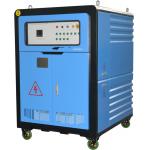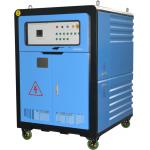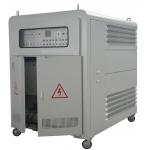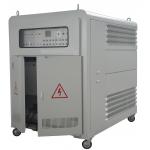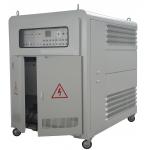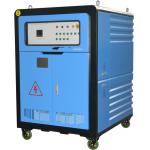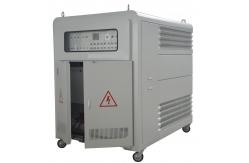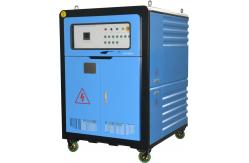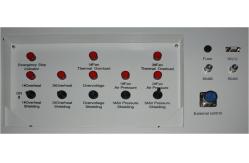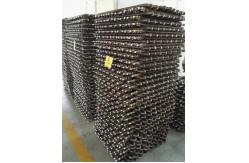600 kw Resistive Load Bank for Generator TestingLead times are currently less than 3 months! Three-phase model options range from small, portable, low-power
units, to high-power, indoor & outdoor permanent resistive load
banks. Models come standard with push-button manual controls as
well as PC software controls offering advanced load profile
solutions for working with complex testing applications.
Units are suitable for various uses including testing of
generators, UPS systems, data center power systems, power supplies,
HVAC systems, and other critical power sources. Single-phase load bank models also available. Design elements incorporate a robust steel outer chassis with
isolated interior chambers for control and load elements. This
ensures electrical components are kept away from dirt and debris
for long-life reliability in harsh test environments. Portable
options include lifting eyes and caster wheels while permanent and
outdoor rated units are available. All resistive load banks come
with multiple built-in automatic safety shutdowns and manual
override shutdown. Benefits- Digital metering for high-precision data read-out
- User controlled manually or through software with programmed load
profile
- Detailed data management, analysis, and report generation through
software
- Automatic load testing allows user to set custom periods of power
and time
- Display of current, voltage, power, power factor, frequency, and
time
- Emergency manual stop button for quick termination of load test
- Automatic stop protection for adverse conditions including
over-load, over-voltage, high temperature, short-circuit
- Optional serial RS-485 Modbus controls
- Optional dry contact terminal controls
- Optional outdoor rated enclosures (available on models over 100kw)
Load Bank FAQ 1. What is a load bank?
A load bank is a device designed to provide electrical loads for
testing various power sources, Including Engine Generators, Battery
Systems, UPS Systems, Inverters, Ground Power Units, Auxiliary
Power Units, Aircraft Power Generators, Wind Generators, and Hydro
Generators etc.
2. Why is Load Testing Important?
Load bank testing will save your time and money in the long run. It
is how you determine the operating status of your primary power
systems. It's also how you exercise backup systems to ensure they
will be available when called upon. Load testing at start-up and
during commissioning and maintenance will detect problematic
conditions before they escalate and cause downtime.
3. What are the different types of load banks?
Resistive, Inductive, capacitive and Resistive/Inductive combined 4. Can the Load Bank test at single phase?
Yes, but the rating available is 1/6 of the rated testing capacity. 5. Is it possible to synchronize multiple Load Banks for Testing?
Yes. Multiple Load Banks can be synchronized to test one generator
but one Load Bank is not able to test multiple generators at the
same time. 6. What is the operating environment for Keypower Load Bank?
Our Load Banks are to be applied where altitude ≤2500m above sea
level,
ambient temp within -15ºC ~ +55ºC and relative humidity ≤98%. 7. What is the different between Keypower standard load bank and
dual voltage?
For example, a KPLB-500 @400V can test full 500kw @400V, and
derating to 165kw only @230V 3 phase. Dual voltage KPLB-500 can
test full 500kw @400V and @230V.
8. What is generator tester 8961?
The generator tester 8961 is used for recalling the data from the
generators you are testing. Then it can create the test report and
sine wave forms. It is good for generator manufacturer and project
commissioning. 9. Is the load bank weatherproof?
Standard type isn't weatherproof, but optional air discharge duct
and cam-lock connectors can be fitted on it to enable weatherproof. 10. Does the load bank support remote monitoring and control?
Standard type doesn't support, but optional programmable Mitsubishi
PLC can be fitted to support remote monitoring and control on
laptop.
Voltage Versions | 240, 400, 480 VAC | kW Models | 1,2,2,5,10, 30, 40, 50, 100, 200, 300, 500, 800 & 1000 kW | Frequency | 50/60 Hz | Resolution | 1 kW | Configuration | Three Phase, 4 Wire Wye or 3 Wire Delta connection available |
|
